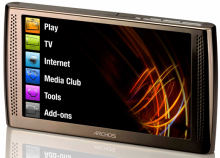Linux PMP adds Android telephony
Feb 10, 2009 — by Eric Brown — from the LinuxDevices Archive — viewsArchos announced a portable media player (PMP) that incorporates Google's Android stack for mobile telephony. Due to ship in the third quarter, the Internet Media Tablet (IMT) is built around a Texas Instruments (TI) OMAP3440 system-on-chip (SoC), supports 3.5G HSUPA service, and offers 500GB of storage, says the company.
The Android-based IMT will combine Android with the company's own Linux-based Archos multimedia framework. It will thus offer smartphone functions, as well as access to Android applications, says the company. It appears from the wording of the announcement that this multimedia framework will continue to run Archos's own implementation of Linux, rather than using the kernel available with the Linux/Java Android stack.
Touted features for the IMT include:
- OMAP3440 processor based on the ARM Cortex A8 superscalar microprocessor and DSP
- 3.5G 7.2Mbps HSUPA
- Android telephony and applications support
- High-resolution 5-inch screen and full-width page viewing
- Adobe Flash and Flash Video support, full screen
- TV recording and High Definition (HD) playback, all formats
- Hundreds of hours of video storage (up to 500 GB)
- Compact 10mm-thin tablet
- Seven hours of video playback
The Android IMT appears to be the first officially announced Android-driven product that falls into the tablet/mobile Internet device (MID) format category. The vast majority of other contenders run two other Linux-based open-source distributions: Intel Atom-based MIDs run the Intel-sponsored Moblin, and Nokia's N810 Internet Tablet runs the Nokia-sponsored Maemo distro. Android is apparently also being considered for Atom-based MIDs, as well as netbooks.
Archos background
Igny, France-based Archos has been making Linux-based PMPs for years, including the PMA400, the Archos 604, and the 7-inch Archos 704. In August, it announced the Archos 5 and Archos 7 tablets, (pictured below) offering 4.8- and 7-inch touchscreens, respectively, and including WiFi and an optional 3.5G HDSPA cellular connection. The tablets both offer hard drive storage — up to 320GB for the Archos 7 — and both offer psuedo-HD playback on their 800 x 480-resolution touchscreen displays. The Archos PMPs lack a slide out keyboard, but provide a virtual keyboard.


Archos 5 (left) and Archos 7
(Click on either to enlarge)
In the fall, an Archos5G version was released, and shortly thereafter, French wireless carrier SFR announced it was offering its subscribers a version of the device, which it dubs the Archos 3G+.
The Archos 5 and Archos 7 were the first tablets we covered to use TI's OMAP3x platform. Archos did not list the exact chip, but likely selected one of the OMAP35xx family of SoCs. Nearly identical to the OMAP3440, which targets mobile phones, the OMAP35xx line targets a wider variety of devices.
ARM vs. x86, phase II
With the help of the OMAP3x, the Archos PMPs appeared to grab the mantle of being the most powerful ARM-based Internet tablets, eclipsing Nokia's N810 Internet Tablet. (Nokia, however, is also planning to move its tablets up to the OMAP3x platform.) What's more, the Archos 5 and Archos 7 tablets offered a design and features that were largely indistinguishable from the Intel Atom-powered MIDs that were beginning to appear around the same time. As such, the tablets, and the upcoming Android IMT, are part of the first ARM Cortex-driven wave of the coming war between ARM and X86 for MIDs, netbooks, and other mobile devices. Meanwhile, Freescale is already sampling its own high-powered Cortex-A8-based platform for mobile devices, the i.MX51 platform.
Archos cites the Android IMT as “the first implementation of the OMAP3440,” (which as noted earlier, suggests the previous Archos 5 and Archos 7 tablets were instead based on the OMAP35xx). Archos chose TI's OMAP3x platform in part “to leverage the company's experience in developing compelling, highly-competitive products based on the Android telephony platform,” says the company. Although TI was a founding member of the Open Handset Alliance (OHA), which oversees the open source Android platform, the only shipping Android phone that we know of, the HTC G1, instead uses a Qualcomm MSM7201A ARM processor. Other OMAP3-based Android devices will likely be announced in the coming months.
The IMT tablet's HSUPA (High-Speed Uplink Packet Access) platform is, like HSDPA, a variant of the 3G HSPA (High Speed Packet Access) protocol. HSUPA adds an enhanced dedicated uplink channel for higher uplink bandwidth, claimed by Archos to range up to 7.2Mbps for the IMT. A list of HSUPA networks at Wikipedia suggests the technology may be offered by ATT Mobility.
Stated Henri Crohas, CEO and Archos founder, “Support for an Android-based device represents a historical opportunity for Archos.”
Stated Remi El-Ouazzane, VP and GM for TI's OMAP platform business unit, “The OMAP 3 platform, with its support for the Android OS, is a powerful tool to support HD video, high quality multimedia, and connectivity anytime and anywhere. Archos' use of TI technologies, including connectivity and analog solutions, helps to push the boundaries.”
Availability
The Archos Android IMT will ship in the third quarter, says the company.
This article was originally published on LinuxDevices.com and has been donated to the open source community by QuinStreet Inc. Please visit LinuxToday.com for up-to-date news and articles about Linux and open source.